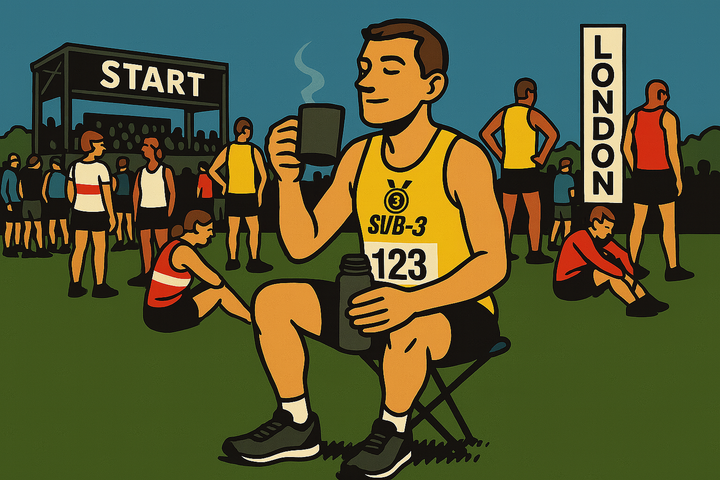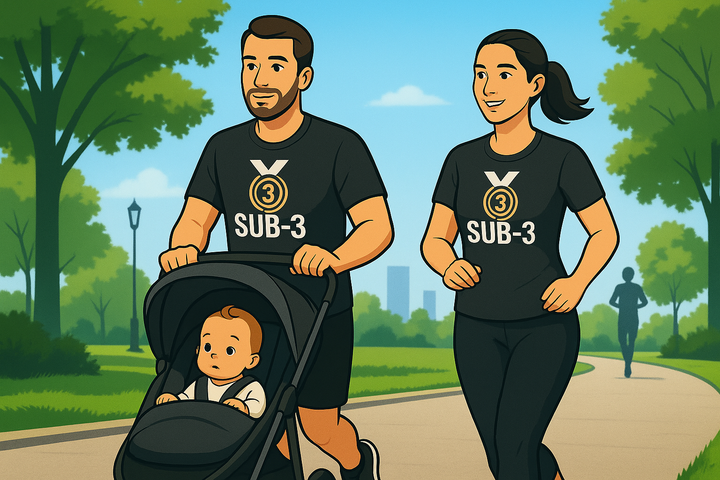Pacing strategies for sub-3 runners
How to run smart, stay strong and finish under 3 hours

There’s no shortage of debate in running circles about pacing strategy – should you run even splits, negative splits or go out hard and hang on? Technically speaking, you need to average 4:15 per kilometre or 6:52 per mile to run a sub-3 marathon. That’s for exactly 42.195km – but as anyone who’s run a city marathon knows, you’ll almost certainly run further.
The truth is, you’re not a robot. You won’t be running on a vacuum-sealed track. Weather, congestion, adrenaline and fatigue all play a part. As the old military adage goes, no plan survives first contact with the enemy – and the same applies on race day.
But the marathon is long enough to make adjustments. A 5K offers no margin for error. A marathon gives you time to get it right. Here’s how.
1. Don’t go out too fast
The start of a marathon is a dangerous cocktail – rested legs, race-day buzz and runners around you sprinting off like it’s a 10K. I’ve done it myself. At London one year, I turned to a friend and said, “We’re running 10K pace!” He carried on. I eased off. I passed him a few miles later.
Going too fast early on risks early glycogen depletion – and a brutal meeting with the wall at mile 20. There’s a reason the cliché exists. Run your first 5K like you’re holding back – because if you don’t, the course will hold you back later.
2. Plan for running long
Most runners cover more than 42.2km in a marathon. In London, I’ve averaged 42.7km over three years. You’ll weave around runners, move to the side for drinks, and rarely stick to the racing line.
To be safe, pace for 43km. That means targeting 4:10/km or 6:43/mile rather than 4:15/km or 6:52/mile. If you end up running closer to the true distance, you’ll be ahead of schedule. But if you plan for 42.2 and run 42.7, that extra half-kilometre can be the difference between triumph and heartbreak.
3. Run your own race
Pacers can be helpful – but they’re not infallible. If you prefer to know they’re behind you rather than be boxed in by a crowd, run just ahead. The key is to listen to your own body. A good race requires focus, not dependence on a stranger with a flag.
You’re not here to tick along behind someone else – you’re here to deliver your own best performance.
4. Break it into segments
Rather than seeing it as one daunting 42km stretch, mentally divide the race into three parts:
- The first half – calm, steady, controlled
- The next 8km – a bit grittier, but manageable
- The final 10K – a test of resolve, focus and discipline
By the time you hit 32K, you’ll need mantras and muscle memory. But if you’ve paced well, you’ll still have enough left to finish strong.
5. Focus on average pace
Live pace fluctuates wildly – especially with buildings, GPS quirks and uneven pacing packs. Average pace tells a truer story. I’ve seen watches jump from 3:40/km to 4:40/km in Canary Wharf with no change in effort.
Just remember: if your average pace starts slipping, it takes sustained effort to fix it. Don’t panic-sprint. Stay calm and gradually reel it back in.
6. Be careful with time “buffers”
Banking time early is tempting – and I’ve done it. In my first sub-3, I reached 20 miles in 2:10, then slowed to sub-5:00/km for the last 10K and still made it. But a buffer isn’t a strategy – it’s a gamble.
Running a half-marathon PB in the first half is a sure route to a miserable second half. If you do build a buffer, keep it small and steady – not explosive.
That said, textbook pacing theory tells us that even splits are the most efficient approach. They reduce physiological stress and energy spikes. Kipchoge’s best performances have followed this blueprint. It’s difficult to execute perfectly – especially in mass events – but worth bearing in mind as the ideal.
7. Factor in the course profile
If you’re running Berlin or Valencia, even pacing is realistic. If you’re tackling Boston or Snowdonia, effort-based pacing is more reliable. Don’t force your watch to hold steady pace on every hill – you’ll burn matches unnecessarily. Let the course dictate effort and aim for smooth splits over effort zones, not clock-time.
8. Adjust for weather
Conditions matter. If it’s unseasonably warm, humid or windy, you may need to slow slightly – especially early on. Stubbornly sticking to sub-3 pace in bad conditions can destroy your race. Dial it back by 5–10 seconds per kilometre for the first half if needed. Even pacing applies to effort, not just numbers.
9. Keep your pacing data simple
Modern watches offer dozens of metrics – but mid-marathon, less is more. Trying to calculate time lost in a tunnel while doing mental arithmetic at kilometre 35 is a recipe for stress.
Stick to one or two fields – average pace and elapsed time – and let the watch support you, not distract you.
10. Avoid getting drawn into mini-battles
It’s easy to get dragged into competitive duels – overtaking someone from your club or chasing down a rival vest. Occasionally that helps break a slump. But often it’s just wasted energy.
Instead, identify someone moving well 10 metres ahead and use them as a focus point. This isn’t about beating others – it’s about extracting the best from yourself.
Final word
The best pacing strategy is the one that gets you over the line in under 3 hours – not the one that looks neat on a spreadsheet. Don’t panic if your splits aren’t textbook. The marathon is a war of attrition. Plan smart, stay calm and adjust as you go.
And remember – the real prize isn’t perfect pacing. It’s crossing the finish line with a time that starts with a 2.
Enjoyed this article? Help keep Sub-3 running — support us with a coffee.
To help fund the running of the site, Sub-3 is an Amazon Associate and earns from qualifying purchases. We only recommend gear or kit that has genuinely helped in our own running and that we believe is worth considering.



